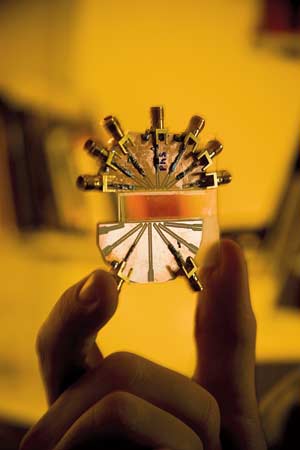Could the technology that MIT’s Michael Bove is working on change computer displays as we know them today? It wasn’t long ago that LCD flat screens took the market over. Are we going to see a similar change when Holographic Video technology matures?
“The Media Lab’s video holograms appear to float above a piece of frosted glass. An electronic device behind the glass, called a light moduÂlator, reproduces interference patterns that encode information about the pictured object. Laser light striking the modulator scatters just as it would if it were reflecting off the object at different angles.
A holographic video begins with a computed 3-D model of some moving object or scene. This model “can be thought of as having a whole lot of points on its surface at different depths that change over time,” Bove says. To make that model holographic, a computer needs to figure out the intensity of the light that would be reflected from each point on the object to the point where the viewer’s eyes will be. “You need to create a diffraction pattern that reconstructs all the different intensities for all the different angles,” Bove says. He found that graphics chips in today’s PCs are adept at doing this sort of 3‑D rendering, computing the diffraction patterns, and combining them into a single video output.”


Permalink
The upper part is the holographic image??
exactly how much processing power are we talking here?
Permalink
@Haseeb Anjum
I think the middle part is some piece of glass like optic stuff. The modulator or something. I suspect this to be the device they have shrunken. Anywayz, this being Hacked Gadgets, where’s the circuits and specifications so we can build this it ourselves?
Permalink
layers of LCD. thats all I have to say.
Permalink
This may be one of those projects that will take a bit of time before we can build it ourselves. 🙂
Permalink
Yeah, how about a real open-air volumetric display. It’s still just layers of LCD, it’s not much of an accomplishment.
Permalink
No, not layers of LCD
>The Media Lab’s video holograms appear to float above a piece of frosted glass.
Permalink
I want one.
Permalink
The MIT holographic displays are true on the fly generated holograms. This
is not about stacking LCDs or about some flickering rotating screen at 12
RPS. This is the real stuff where you can stick your finger in. Try that with
a rotating screen.
Permalink
I didnt mean “this is layers of LCD” I ment ” somethin like this could be ACCOMPLISHED by layers of LCD”
Permalink
joebob: lol, then how would you wave your hand through it?
Permalink
Permalink
http://www.technologyreview.com/player/07/07/MagDemo/1.aspx
Permalink
Yah the same holographic effect has now been possible with the help of play station 3. I have saw a review on a video site about the playstation3. What all is been discussed here about holographic video is really interesting to know. Soon we all will be able to feel the virtual reality.
Permalink
check this product for digital signage. looks like holography
http://www.illusionscreen.com
Permalink
check this product ! looks like hologram
http://www.illusionscreen.com